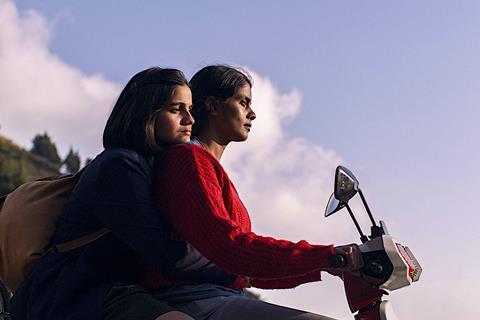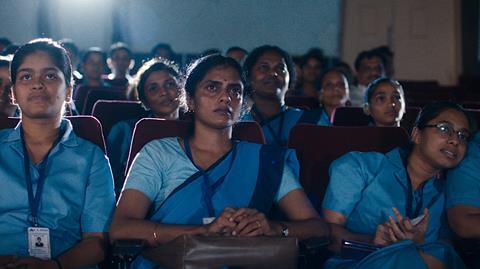
Girls Will Be Girls director Shuchi Talati says 2024 is an incredible year for independent Indian women filmmakers. “We’re collectively creating a tapestry of stories that have not been given space in our culture,” she says.
Talati’s debut feature set the tone in January by winning the audience award in the World Cinema Dramatic Competition at the Sundance Film Festival while its 22-year-old lead actress, Preeti Panigrahi, bagged the special jury award for acting. The mother-daughter drama was more than six years in the making, with Talati first pitching it at the 2018 NFDC Film Bazaar Co-Production Market.
She hasn’t been the only Indian woman making waves at top festivals: Payal Kapadia’s debut fiction feature All We Imagine As Light created history for India by winning the Grand Prix at Cannes Film Festival; Rima Das’ sequel to her acclaimed 2017 film, Village Rockstars 2, bagged the Kim Jiseok award in Busan.

“In some ways, it’s a coincidence that all our films came to fruition at the same time,” says Talati, “This year might seem like an outlier but I do believe a shift is happening in the industry.”
This new wave of female storytelling from India also includes more 2024 festival hits, all debut features: Lakshmipriya Devi’s Boong played in Toronto; Subhadra Mahajan’s Second Chance premiered at Karlovy Vary; Nidhi Saxena’s Sad Letters Of An Imaginary Woman travelled to Busan.

Meanwhile, Kiran Rao’s sophomore effort, Lost Ladies, which premiered at Toronto 2023, is India’s official entry for the international feature Oscar and was released theatrically in the US and internationally by Jio Studios.
Female documentarians are also in the spotlight: Nocturnes, co-directed by Anupama Srinivasan and Anirban Dutta, won a special jury award at Sundance and Nishtha Jain’s Farming The Revolution was crowned best international feature doc at Hot Docs. Kartiki Gonsalves’s The Elephant Whisperers, produced by India’s leading female producer Guneet Monga, won the Oscar for best documentary short in 2023.
“I feel honoured to be a small part of this indie feminist film wave,” says Second Chance director Mahajan.
On the horizon
This wave looks set to surge in the future. This year’s International Film Festival of India (IFFI) is screening 47 films directed by women. The Women in Cinema section will highlight emerging talent and the significant contributions of female filmmakers.
The Co-Production Market at NFDC Film Bazaar this year spotlights five film projects by female filmmakers: Saraswathi Vani Balgam’s Destiny’s Dance (Aadu Ki Kasam), Nihaarika Negi’s Feral, Kunjila Mascillamani’s The Last Of Them Plagues (Guptam), Payal Sethi’s The Disappearing Flower (Kurinji) and Aastha Tiku’s Wax Daddy.
The web series projects include Anu Vaidyanathan’s Modern Times, Ruchika Oberoi’s Just Like Her Mother, Drishya Gautham’s Indi/Pendent and Shivangi Singh’s Chauhan’s BNB - Bed And Basera.
Women have been making films in India for nearly a century, starting with Fatma Begum, whose 1926 film Bulbul-e-Paristan is often cited as the first Indian film by a female filmmaker. Women filmmakers travelling the international festival circuit since then include Aparna Sen, Nandita Das, Leena Yadav, Shonali Bose, Zoya Akhtar and Reema Kagti, among others (not also forgetting India-born Mira Nair or Deepa Mehta).
Yet the difference in 2024 is how the industry is giving them more space and attention. Still, at home in India, data and statistics can be harder to come by than in other territories: it’s impossible to prove if more women are going to film schools or if more funders are backing female films with bigger budgets.
Only anecdotal evidence helps join the dots. “Where there used to be one or two women amongst six or eight participants in labs and programmes, now at least half that number is female. There are programmes specific to female filmmakers. Festival programming teams and juries have more women, as do official selections,” says Mahajan.
Talati agrees: “Labs and grants are aware of the inequities in the system and are actively trying to correct them.”
Shyam Bora, the producer of Mahajan’s film, says that female-oriented programmes like WIFTI or the EWA or funders like Chicken & Egg Films, are rising in the US and Europe much more so than in India. “We don’t have any funding or production support just for women filmmakers. Our current industry can do a lot more to encourage them,” he says.
Filmmaker Nidhi Saxena thinks the Internet has cut down on barriers to entry and opened more opportunities for women filmmakers in the teeming global industry. “What has increased with the Internet is the access to cheaper technology, knowledge sharing and increased opportunities to network, often among ourselves,” she says.
Kunjila Mascillamani takes the credit for any success back to women filmmakers themselves who have toiled for years, faced sexism and systemic inequities and hurdles and risen above them. “If there has been support at all, it’s from very few kind-hearted individuals but that is not enough. What we are looking for is affirmative action from organisations,” she says.
Kerala State Film Development Corporation has been funding two films annually by women filmmakers under its Films Directed by Women scheme launched in 2019. Forbidden (Nishiddho) by Tara Ramanujan and Divorce by Mini IG were the first of these projects. According to Mascillamani, it is a step in the right direction and should be emulated by the rest of the country.
Going beyond ‘women’s stories’

In such a challenging backdrop, Kapadia’s win at Cannes has offered hope for increased confidence in women filmmakers by the stakeholders, both investors and public audiences.
While filmmakers like Farah Khan and Zoya Akhtar have historically performed well at the Indian box office with their Bollywood films, Kapadia’s film has the globe as its playground with Janus Films and Sideshow acquiring the North American rights and French sales outfit Luxbox selling to at least 25 other countries (Spirit Media holds the Indian rights).
As an audience member herself, Nishtha Jain gravitates towards films made by women. “More often than not, I find a fresh perspective or certain delicacy or tenderness or sharpness in approach,” she says.
However, she doesn’t like being pigeonholed just as a woman filmmaker. “This way gender is given predominance and being a woman filmmaker alone doesn’t ensure that we’ll be watching something new,” she says.
According to her, awareness is the key factor, not identity. “It’s the experiences of women in a patriarchal society that can make them acutely aware and give them an insight that a filmmaker in a dominant role might not have access to,” she adds.
For so long, Indian films have been made from a male perspective. Mahajan adds, “It’s high time we see a variety of films featuring characters of all genders, across genres and formats, told from a female perspective.”
But there is also the urge in many women filmmakers to go beyond just telling women’s stories. “I could talk politics, crypto or traffic jams,” adds Saxena.
Mascillamani admits that gender is not a conscious choice but has come up in her work coincidentally. Her Film Bazaar project this year is about a single mother and the problems she faces in a conservative place. “There is this inordinate pressure on women filmmakers to come up with women’s empowerment stories,” she says. However, she also loves crime thrillers and horror.
Talati’s aim is to put experiences on screen that have otherwise not been given space and time in cinema – such as the Himalayas-set mother-daughter story she tells in Girls Will Be Girls.
“As a woman I often see things missing in terms of how women are represented. I don’t see the complexity of our experiences. So, when I get down to writing, these wonderful, subversive, interesting, defiant women characters often come up and when they are at the centre of the story, it’s hard to take gender out of the equation especially in an imperfect world such as ours.”

























No comments yet